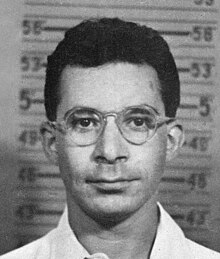
Back Louis Slotin Afrikaans لويس سلوتن Arabic Луис Злотин Bulgarian Louis Slotin Czech Louis Slotin German Louis Slotin Esperanto Louis Slotin Spanish لوئیس اسلوتین Persian Louis Slotin Finnish Louis Slotin French
Louis Slotin | |
|---|---|
 Slotin's Los Alamos badge photo | |
| Born | Louis Alexander Slotin 1 December 1910 Winnipeg, Manitoba, Canada |
| Died | 30 May 1946 (aged 35) |
| Cause of death | Acute radiation syndrome |
| Education | |
| Occupation(s) | Physicist and chemist |
| Known for | Criticality tests on Plutonium & nuclear weapons assembling, the Dollar unit of reactivity |
Louis Alexander Slotin (/ˈsloʊtɪn/ SLOHT-in;[1] 1 December 1910 – 30 May 1946) was a Canadian physicist and chemist who took part in the Manhattan Project. Born and raised in the North End of Winnipeg, Manitoba, Slotin earned both his Bachelor of Science and Master of Science degrees from the University of Manitoba, before obtaining his doctorate in physical chemistry at King's College London in 1936. Afterwards, he joined the University of Chicago as a research associate to help design a cyclotron.
In 1942, Slotin was invited to participate in the Manhattan Project, and subsequently performed experiments with uranium and plutonium cores to determine their critical mass values. After World War II he continued his research at Los Alamos National Laboratory in New Mexico. On 21 May 1946, he accidentally began a fission reaction which released a burst of hard radiation. He was rushed to the hospital and died nine days later on 30 May. Slotin had become the victim of the second criticality accident in history following Harry Daghlian, who had been fatally exposed to radiation by the same plutonium "demon core" that killed Slotin.
Slotin was hailed as a hero by the United States government for reacting quickly enough to prevent the deaths of his colleagues. However, some physicists argue that Slotin's behavior preceding the accident was reckless and that his death was preventable. The accident and its aftermath have been dramatized in several fictional and non-fiction accounts.
- ^ The Slotin Accident. AtomicHeritage. YouTube. 18 October 2017. Retrieved 19 February 2024.
© MMXXIII Rich X Search. We shall prevail. All rights reserved. Rich X Search